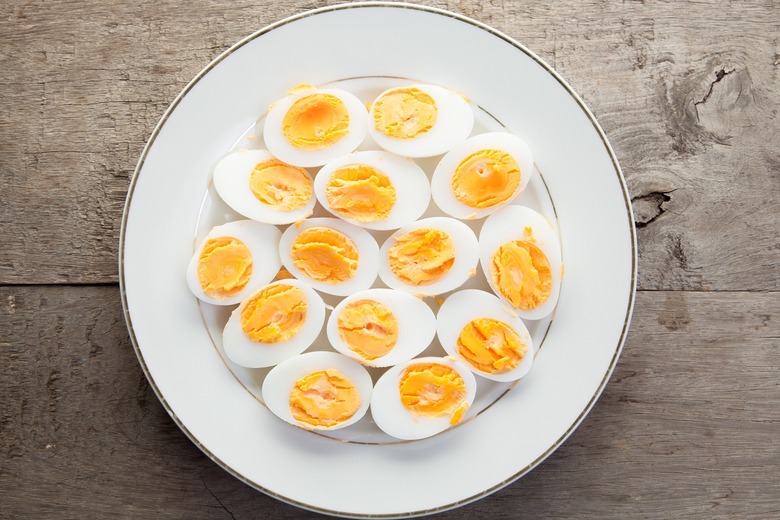How To Hard Boil Eggs And Peel Them Perfectly Every Time
Making hard-boiled eggs is an essential cooking skill, and while it seems easy, the results often come up just short of perfect. Whether you're looking for a quick, healthy breakfast or are trying to make some scrumptious deviled eggs, knowing how to hard-boil eggs perfectly every time — and knowing what not to do — is a must.
Recipes That Use A Lot of Eggs
The two most common problems that arise when trying to make hard-boiled eggs are improper doneness (because nobody likes sulfuric green yolks) and egg shells that just won't peel off without taking a big chunk of the white with them.
To make the process easier, use this headache-free five-step method for the easiest hard-boiled eggs:
Step 1: Use the right eggs
It is best to use eggs that are just past peak freshness, though not expired or bad. The outer membrane in a fresh egg tends to cling to the shell more than in an older egg, making the peeling process more difficult. Here's the easiest way to tell if your eggs have gone bad.
Step 2: Place the eggs in a pot
Place the eggs in a pot, cover completely with cold water, and put the pot on the stove. Add in a small splash of white vinegar, if desired. It's rumored to help with peeling.
Step 3: Bring the cold water to a boil over high heat
After your eggs, water and a tiny splash if vinegar are in your pot, bring the cold water to a boil over high heat, leaving the pot uncovered. Once the water arrives at a rolling, bubbling boil, turn the heat off, cover the pot and remove it from the heat. Allow the eggs to sit in the water until they are cooked; 9 minutes for medium-sized eggs and 12 minutes for large eggs. This timing ensures that the eggs will be perfectly cooked with bright yellow yolks and non-rubbery egg whites.
Step 4: Give the eggs an ice bath
When the timer goes off, remove the eggs from the hot water and place them in a large bowl of ice-cold water to halt the cooking process and lower the temperature of the eggs. When the eggs reach room temperature, it's time to peel them — any colder and they'll be tougher to peel.
Step 5: Peel the eggs
Roll the egg under your palm on the counter so that the shell is broken and cracked all over, and then submerge the egg in your bowl of room-temperature water. This will help to loosen the membrane that connects the white to the shell. While the egg is still submerged, begin to peel it. You can also opt to peel the eggs under the running water of the faucet so the added pressure of the water can work to remove the shells, too.
Voila! Perfect hard-boiled eggs! Your delicious eggs are now ready for any preparation. Slice them and sprinkle with salt, layer them on a Cobb salad, turn them into delicious deviled eggs, or use them as a building block for some of these 101 best ways to eat an egg!
If you need extra guidance, watch our video below on how to hard boil and peel and egg. Then head to The Daily Meal's YouTube channel for even more inspiration and know-how.
.
